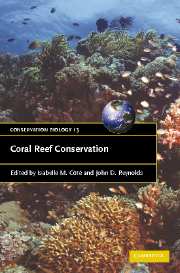Book contents
- Frontmatter
- Contents
- List of contributors
- Foreword
- Preface
- Part I Setting the stage
- Part II Uses and abuses: ecological and socio-economic issues
- Part III The way forward: tools and approache
- 9 New approaches to estimating recent ecological changes on coral reefs
- 10 Assessing the effectiveness of marine protected areas as a tool for improving coral reef management
- 11 Environmental impact assessment for coral reefs: advocating direct protective approaches
- 12 Time for a third-generation economics-based approach to coral management
- 13 Collaborative and community-based conservation of coral reefs, with reference to marine reserves in the Philippines
- 14 Education as a tool for coral reef conservation: lessons from marine protected areas
- 15 Adaptive institutions for coral reef conservation
- 16 Coral reef restoration with case studies from Florida
- 17 Redesigning coral reef conservation
- 18 Coral reef coda: what can we hope for?
- Index
- Plate section
- References
14 - Education as a tool for coral reef conservation: lessons from marine protected areas
Published online by Cambridge University Press: 05 June 2012
- Frontmatter
- Contents
- List of contributors
- Foreword
- Preface
- Part I Setting the stage
- Part II Uses and abuses: ecological and socio-economic issues
- Part III The way forward: tools and approache
- 9 New approaches to estimating recent ecological changes on coral reefs
- 10 Assessing the effectiveness of marine protected areas as a tool for improving coral reef management
- 11 Environmental impact assessment for coral reefs: advocating direct protective approaches
- 12 Time for a third-generation economics-based approach to coral management
- 13 Collaborative and community-based conservation of coral reefs, with reference to marine reserves in the Philippines
- 14 Education as a tool for coral reef conservation: lessons from marine protected areas
- 15 Adaptive institutions for coral reef conservation
- 16 Coral reef restoration with case studies from Florida
- 17 Redesigning coral reef conservation
- 18 Coral reef coda: what can we hope for?
- Index
- Plate section
- References
Summary
INTRODUCTION
Education is pivotal to the success of coral reef conservation. From local to global and from policy to practice, public understanding of human interactions with the natural world plays a vital role in the development of sustainable solutions to environmental challenges. Without it, how can we possibly expect individuals – be they politicians, fishers or tourists – to compromise short-term interests for long-term gain? In the context of the modern shift towards participatory decision-making, stakeholder education has the potential to become the most powerful and fundamental force in the sustainable management of the marine environment. Many conservation programmes have long recognized this potential and have sought to realize it in diverse ways.
This chapter – published during the first year of the UN Decade of Education for Sustainable Development – considers the role of education in coral reef conservation, including drivers for education, tools and techniques and evaluation. We focus in particular on marine protected areas (MPAs) because these are the coral reef conservation tool that has made greatest use of educational initiatives. There is a host of MPA programmes, centres, services and materials designed to engage the interest of the general public or specific groups in the coral reef environment and associated issues. But do these programmes really work? And how do they interact with other conservation tools? Although most of the examples we have included relate to education in MPAs, we believe that the points arising from them also have a wider significance.
- Type
- Chapter
- Information
- Coral Reef Conservation , pp. 419 - 454Publisher: Cambridge University PressPrint publication year: 2006
References
- 1
- Cited by



